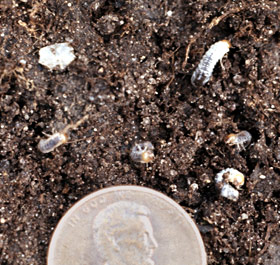Black Turfgrass Ataenius, Ataenius spretulus (members of Scarab Beetle family)

Whitney Cranshaw, Colorado State University, Bugwood.org.
IPM Steps to Reduce Black Turfgrass Ataenius
1. Sample for Pest
Confirm the presence of black turfgrass ataenius before you treat.
Where to find it while inspecting: Adults are most easily found in spring (varies to zone), roughly early to late May. For larval damage, examine brown patches in turf. Damage causes turfgrass to lift up easily (similar to other white grub damage and the “carpet effect”). BTA adults and larvae are small so focus your search on high-end turf that receives irrigation and fertilizer.
2. Proper ID
Are they black turfgrass ataenius?
Size and Appearance: Adult BTA is a shiny black beetle no more than 5 mm long (0.2") grubs resemble other scarab beetle “white grubs” though much smaller.
3. Learn the Pest Biology
What is the life cycle of black turfgrass ataenius?
Life Cycle: Adult BTA overwinter in woodlots and fly in to turf in May and June where they lay eggs in the thatch. Grubs feed over a two month period at roots and crown (damage will become visible by late July). Grubs pupate in July and emerge as adults in August.
Preferred Food Sources: Turfgrass roots and stems.
Preferred Habitat: Overwinter in rough turf in woodlots: eggs, larvae and pupae are found in well-maintained turf, primarily golf course fairways and greens.
4. Determine Threshold
How many black turfgrass ataenius are too many?
Threshold: In healthy turf, high numbers of larvae can be tolerated: 50 or more per square foot, found in the thatch layer of turf.
5. Choose Tactics
Creating a healthy soil condition and understanding turfgrass’s needs is the first step in reducing turf pests. What can I do to treat, reduce, or prevent black turfgrass ataenius?
Best Management Practices: The best defense is healthy turf. Increase drainage and avoid light frequent irrigation, summer fertilization, and close mowing or scalping. Reduce soil compaction by limiting traffic, especially when the soils are wet; core aerify when the turf is actively growing. Encourage natural enemies in soil by avoiding insecticides: ground beetles, rove beetles, ants and spiders.
Treatment Methods: If damage warrants, insecticide treatments are available where allowed by law.
6. Evaluate
Was the tactic successful? Record the date pests were first noted, and the tactic you used, and its success. Use one of our RECORD KEEPING tools.
For More Information:
Ohio State University: Black Turfgrass Ataenius and Aphodius
Remember:
When a pesticide application is necessary, all necessary and required precautions are taken to minimize risk to people and the environment and to minimize risk of pesticide resistance or pest resurgence. Pesticide use in your school may be prohibited or regulated by local policies or state and federal regulations. Risk reduction methods can include, but are not limited to, spot-treatment, the use of gel or paste bait formulations placed in inaccessible locations, injection into a crack or crevice, and other methods that reduce potential exposure.